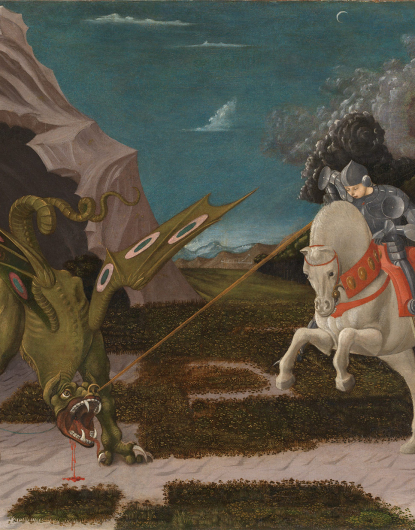Masterpieces from the Lanckoroński Collection
July 1 – October 2, 2022
EXHIBITION ON THE 2ND FLOOR OF THE CASTLE (IN ROYAL PRIVATE APARTMENTS)
Paintings from the former Viennese art collection of Count Karol Lanckoroński, that his daughter Karolina donated in 1994, have become a fixture in the chambers of Wawel Royal Castle. Works inspired by the writings of Ovid, Apuleius, Virgil, and Livy harmoniously complement the 16th-century ceilings of the Renaissance interiors of the first floor that they adorn. Religious paintings—panels from Italian altarpieces scattered in the 19th century, and small pictures intended for private devotion are on view in the intimate setting of the Jordanka tower, a relic of the former Gothic castle incorporated into the fabric of the Renaissance residence. Two pictures stand out in this group: Simone Martini’s Angel and the Virgin and Child Enthroned by Bernardo Daddi, once the central panel of an altarpiece from the church of Santa Maria del Carmine in Florence.
This extraordinary collection was assembled by an enthusiast of Italy and the quattrocento, as Karol Lanckoroński’s contemporaries described him. He bought paintings on the European antiquarian market in the last decades of the 19th century and the first years of the 20th. His collection of Italian paintings, in which works from the 15th and 16th centuries predominated, was one of the most famous private collections in Europe. In the neo-Baroque palace at Jacquingasse 18 one could admire such masterpieces as Saint George and the Dragon by Paolo Uccello, Saint Andrew by Masaccio, and the Annunciation by Francesco Pesellino. His highly acclaimed works also included Hans Holbein the Elder’s Portrait of Philipp Adler, ranked among the best portraits by the German Old Master. Today, they are all in major international museums.
Lanckoroński’s enormous collection of ancient and oriental art, textiles, porcelain, numismatic items, and paintings by Italian, Dutch, German, French, and Spanish artists was gradually sold by his heirs after World War II. Aware of the artistic and historical value of the works which had once belonged to King Stanisław August Poniatowski and of the Italian paintings of the 15th and 16th centuries, Karolina Lanckorońska decided to exclude this part of the family legacy from sale with a view to transferring it to Polish museums. The exhibition held on the twentieth anniversary of her death, reminds us of her and her extraordinary gift, unmatched in Poland’s post-war history.
Among the paintings that found their way to the European art market in the postwar years were the three featured in this exhibition: Uccello’s Saint George and the Dragon, probably acquired by Lanckoroński before 1892, now in the National Gallery in London, the Portrait of a Girl in the manner or Bartholomaeus Bruyn the Elder from the Ackland Art Museum in Chapel Hill, bought by the count in 1888 at a sale of the estate of painter Hans Makart, and Company in a Garden by Barend Graat from the former collection of King Stanisław August, now in the Rijksmuseum in Amsterdam. They were among the finest paintings in Lanckoroński’s collection.
EXHIBITION ON THE 2ND FLOOR OF THE CASTLE (IN ROYAL PRIVATE APARTMENTS)
Paintings from the former Viennese art collection of Count Karol Lanckoroński, that his daughter Karolina donated in 1994, have become a fixture in the chambers of Wawel Royal Castle. Works inspired by the writings of Ovid, Apuleius, Virgil, and Livy harmoniously complement the 16th-century ceilings of the Renaissance interiors of the first floor that they adorn. Religious paintings—panels from Italian altarpieces scattered in the 19th century, and small pictures intended for private devotion are on view in the intimate setting of the Jordanka tower, a relic of the former Gothic castle incorporated into the fabric of the Renaissance residence. Two pictures stand out in this group: Simone Martini’s Angel and the Virgin and Child Enthroned by Bernardo Daddi, once the central panel of an altarpiece from the church of Santa Maria del Carmine in Florence.
This extraordinary collection was assembled by an enthusiast of Italy and the quattrocento, as Karol Lanckoroński’s contemporaries described him. He bought paintings on the European antiquarian market in the last decades of the 19th century and the first years of the 20th. His collection of Italian paintings, in which works from the 15th and 16th centuries predominated, was one of the most famous private collections in Europe. In the neo-Baroque palace at Jacquingasse 18 one could admire such masterpieces as Saint George and the Dragon by Paolo Uccello, Saint Andrew by Masaccio, and the Annunciation by Francesco Pesellino. His highly acclaimed works also included Hans Holbein the Elder’s Portrait of Philipp Adler, ranked among the best portraits by the German Old Master. Today, they are all in major international museums.
Lanckoroński’s enormous collection of ancient and oriental art, textiles, porcelain, numismatic items, and paintings by Italian, Dutch, German, French, and Spanish artists was gradually sold by his heirs after World War II. Aware of the artistic and historical value of the works which had once belonged to King Stanisław August Poniatowski and of the Italian paintings of the 15th and 16th centuries, Karolina Lanckorońska decided to exclude this part of the family legacy from sale with a view to transferring it to Polish museums. The exhibition held on the twentieth anniversary of her death, reminds us of her and her extraordinary gift, unmatched in Poland’s post-war history.
Among the paintings that found their way to the European art market in the postwar years were the three featured in this exhibition: Uccello’s Saint George and the Dragon, probably acquired by Lanckoroński before 1892, now in the National Gallery in London, the Portrait of a Girl in the manner or Bartholomaeus Bruyn the Elder from the Ackland Art Museum in Chapel Hill, bought by the count in 1888 at a sale of the estate of painter Hans Makart, and Company in a Garden by Barend Graat from the former collection of King Stanisław August, now in the Rijksmuseum in Amsterdam. They were among the finest paintings in Lanckoroński’s collection.
















